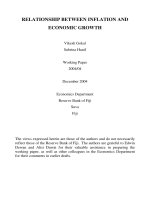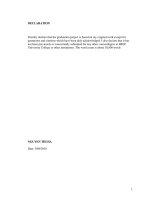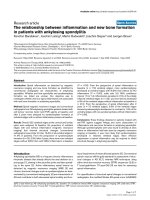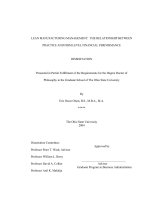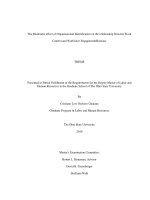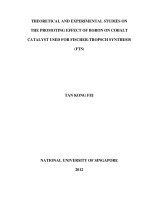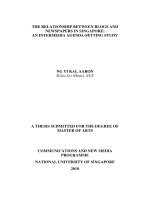The relationship between internationalization and manufacturing firms’ performance in vietnam the moderating effect of organizational slacks
Bạn đang xem bản rút gọn của tài liệu. Xem và tải ngay bản đầy đủ của tài liệu tại đây (1.03 MB, 86 trang )
UNIVERSITY OF ECONOMICS
INSTITUTE OF SOCIAL STUDIES
HO CHI MINH CITY
THE HAGUE
VIETNAM
THE NETHERLAND
VIETNAM - NETHERLANDS
PROGRAMME FOR M.A IN DEVELOPMENT ECONOMICS
The Relationship between Internationalization
and Manufacturing Firms’ Performance in
Vietnam: The Moderating Effect of
Organizational Slacks
BY
HUYNH THI NGOC HIEN
MASTER OF ARTS IN DEVELOPMENT ECONOMICS
HO CHI MINH CITY, Dec 2014
UNIVERSITY OF ECONOMICS
INSTITUTE OF SOCIAL STUDIES
HO CHI MINH CITY
THE HAGUE
VIETNAM
THE NETHERLANDS
VIETNAM - NETHERLANDS
PROGRAMME FOR M.A IN DEVELOPMENT ECONOMICS
The Relationship between Internationalization and
Manufacturing Firms’ Performance in Vietnam: The
Moderating Effect of Organizational Slacks
A thesis submitted in partial fulfilment of the requirements for the degree of
MASTER OF ARTS IN DEVELOPMENT ECONOMICS
By
HUYNH THI NGOC HIEN
Academic Supervisor:
NGUYEN VAN PHUONG PhD.
HO CHI MINH CITY, Dec 2014
CERTIFICATION
“I certify that the substance of this thesis has not already been submitted for any degree
and have not been currently submitted for any other degree.
I certify that to the best of my knowledge and help received in preparing this thesis and
all sources used have been acknowledged in this thesis.”
HUYNH THI NGOC HIEN
ACKNOWLEDGEMENTS
In order to successfully complete this thesis, I received unconditional helps from
many people. I very appreciate the contribution of everyone involved and apologize to
those I do not mention by name.
Firstly, I would like to express my gratitude to my supervisor, PhD. Nguyen
Van Phuong. His instructions as well as encouragements are the key factor of my
dissertation completion and enabled me to turn my concerns into a serious academic
research. He was not afraid of time-consuming to hold frequent meetings and response
timely to my thesis problems. Moreover, he also took time to review the STATA
programming and offer many flexible ways to support me in data processing step – the
most challenging part in my study.
Secondly, I am also grateful for PhD. Nguyen Trong Hoai and PhD. Tran Tien
Khai because their valuable comments and suggestions for my TRD at the beginning
helped me to orient and revise my research design in a proper way.
Next, I also received the surprising help from PhD. Truong Dang Thuy who
appears to be available on email regardless day or night.
Then, I want to say thanks for the moral support from my peer - Ms. Vu Thi
Khanh. She was very patient in applying many different approaches to find the most
appropriate model for her research. Therefore, I have learned from her too much, both
econometric knowledge and a serious attitude toward addressing the thesis issues.
Finally, I wish to express my sincere thanks to my parents, my younger brother,
my relatives and my friends for their continual encouragements, love for my progress
and success.
ABSTRACT
As the world moves toward global expansion, the global enterprises in both
developed and developing countries have been becoming the main drivers of this
process. Although there are many empirical studies on the actual relationship between
internationalization and performance, the question is still relatively ambiguous due to
controversial findings. Thus, this study uses a panel sample of 45491 unlisted Vietnam
manufacturing enterprises during the six-year period (2007-2012) surveyed by GSO
(General Statistic Office) to investigate the impact of internationalization degree on
firm performance. It is widely admitted that the Vietnamese economy is mainly based
on the credit market which is relatively frail and frequently affected by the changes in
the local fiscal and monetary policies. Under these contexts, firm’ abundant slack
resource
is
a
miracle
tool
to
enable
the
successful
implementation
of
internationalization strategies. After conducting the fixed effect analysis, the study
finds a significant S-shaped relationship between degree of internationalization (DOI)
and firm performance. Specifically, the performance firstly decrease then increase and
decline in the later stage. Furthermore, the regression depicts that the higher level of
slacks on both kind of high-discretion and low-discretion is, the better the firm
performs. Especially, the sufficient slacks contribute to enhance the relationship
between internationalization and performance.
ABBREVIATIONS
ASEAN
Association of Southeast Asian Nations
DOI
Degree of internalization
EU
European Union
FDI
Foreign direct investment
FEM
Fixed effect model
REM
Random effect model
FS
Foreign sale
IFs
Internationalized firms
OLS
Ordinary Least Squares
R&D
Research and Development
ROA
Return on assets
TS
Total sale
US
United Joint Stocks
VIF
Variance Inflation Factors
TABLE OF CONTENTS
I.
INTRODUCTION .....................................................................................................1
Problem Joint Stockment..............................................................................1
Research objectives: .....................................................................................6
Research questions: ......................................................................................6
Research Methodology .................................................................................6
Organization of the Study.............................................................................7
II.
LITERATURE REVIEW....................................................................................8
Theoretical review..................................................................................8
Concept of Internationalization .......................................................8
The degree of internationalization and firm performance .............11
Organizational slacks .....................................................................16
Empirical review ..................................................................................19
Internationalization and firm performance ....................................19
Organizational slacks, internationalization and firm performance 23
III.
METHODOLOGY............................................................................................28
Data and Sample...................................................................................28
Variables and measures........................................................................29
Performance.............................................................................29
Independent variable ...............................................................30
Organizational slacks – the moderating variables...................30
Control variables .....................................................................31
Firm size ...........................................................................31
Firm age ............................................................................32
ICT use..............................................................................32
Learning capability ...........................................................33
R&D intensity ...................................................................33
Ownership types ...............................................................34
Analytical approach..............................................................................36
IV.
FINDINGS ........................................................................................................41
V.
CONCLUSION AND RECOMMENDATIONS..............................................55
Main findings..............................................................................................55
Recommendations.......................................................................................55
Limitation....................................................................................................56
REFERENCES
APPENDIX
LIST OF TABLES
Table 1: Summary of variables, measures and expected sign .......................................34
Table 2: Variables definition..........................................................................................41
Table 3: Descriptive statistic and correlations ...............................................................44
Table 4: The comparison between the FEM models with different added variables ....45
Table 5: Fixed effect analysis ........................................................................................49
Table 6: Results of OLS, fixed-effect and random-effect regression analyses on firm
performance....................................................................................................................50
LIST OF FIGURES
Figure 1: Structure of Vietnam export turnover in 2012 .................................................2
Figure 2: Vietnam’s export destination has changed little in the last ten years...............3
Figure 3: Internationalization process..............................................................................9
Figure 4: Three-stage theory (S-shaped) of international expansion (Contractor et al,
2003)...............................................................................................................................13
Figure 5: Role of slacks within an organization ............................................................18
Figure 6: Firm’s internationalization and performance: the moderating effect of highdiscretion slack (Lin, Liu & Cheng, 2011) ....................................................................27
Figure 7: Firm’s internationalization and performance: the moderating effect of lowdiscretion slack (Lin, Liu & Cheng, 2011) ....................................................................27
Figure 8: Illustration of moderating variable .................................................................37
Figure 9: Model..............................................................................................................40
I. INTRODUCTION
Problem statement
In the early twenty-first century, the world witnessed a spectacular
change that the firms from developing countries have started to play an
important role in the global market (Chittoor, 2009). However, it was also
admitted that most of these new internalized firms are still in the early stage of
internationalization process and mainly focus on the market exploration and
export activities (Aulakh, Kotabe & Teegen, 2000).
In recent years, Vietnam has also developed the important steps in the
global integration by the increasing level of international sales. The total export
turnover in 2012 reached an impressive number of US$ 114.6 billion thanks to
the sustainability of labor-intensive manufacturing industries and the dramatic
rise of high-tech manufacturing industries.
Especially, in 2012, the export volume of high-tech items (US$12.7
billion) such as computers, cell phones and parts, accessories, automobile
components tend to gradually outperform than the key traditional export items
such as garments, footwear, furniture and processed agricultural products as
the figure 1. In the first quarter of 2013, the export volume continued to
increase by 16% compared to the same period in 2012 (World Bank, 2013).
These are the good signals for Vietnam toward our global expansion strategy.
Undoubtedly, a wide range of manufacturing industries from handicraft
to high-tech have been becoming the key sectors for promoting the global
1
integration process in Vietnam. The manufacturing industry also relates many
stakeholders in the supply chain and uses inputs such as materials, tools,
machines, chemical & biological methods, etc. to make the final goods for
consumption or sale (Porter, 1985). Therefore, this study takes into account the
case of Vietnamese manufacturing firms due to their considerable
contributions to Vietnam’s internationalization process in recent years.
Figure 1: Structure of Vietnam export turnover in 2012
Although there is a very brilliant picture for Vietnamese firms toward
the global expansion, Aulakh, Kotabe & Teegen (2000) believed that most of
newly internationalized firms from emerging world are still in the early stage
of global expansion. The three-stage theory of Contractor, Kundu, & Hsu
2
(2003) pointed out that at the early stage, IFs suffer the instability of importing
markets and arise an urgent demand to increase market knowledge.
The figure 2 depicts that the export share of Vietnamese manufacturing
firms to the large markets such as Europe, United Joint Stocks, Japan, ASEAN
countries is relatively stable during the past decade from 2002 to 2012.
However, in fact some giants in the manufacturing industry have been
accounted for a major proportion of total export volume rather than the new
IFs who have little chances and inadequate financial resources to sustain their
new ventures. So far, the gains of internationalization, specifically the gains
from export intensity, are still ambiguous for domestic IFs. That is the reason
why many enterprises choose to be safe in the local market without taking risks
to expand globally.
Figure 2: Vietnam’s export destination has changed little in the last ten years.
3
It is widely accepted that internationalization occurs when the domestic
enterprises get involved in the international markets (Johanson, & Vahlne,
1977).
In this way, these firms will take competitive advantages from
company brand identity and market expansion (Hutchinson et al., 2007).
However, the internationalization process contains both benefits and costs,
especially; it is a big challenge for domestic firms to deal with fierce
competition, transaction cost, market volatility and cultural diversity (Eriksson,
Johanson, Majkgård & Sharma, 1997).
Further, many Vietnamese enterprises must consider the tradeoff
whether only operating locally or entering the international markets.
Especially, under the Joint Stock of Vietnam’s tightening monetary policy and
relentless crises, the available financial resources for firms to internalize
become too scarce to invest on global expansion.
Bourgeois (1981) introduced the concept of organizational slacks
referring to the availability of financial resources used for implementing
internal and external changes. Once the firms possess the high level of
organizational slacks, they are more willing to invest on new chances, for
instance, invest to expand the markets globally (Sharfman, Wolf, Chase &
Tansik, 1988). Moreover, organizational slacks also directly contribute to firm
performance by providing the capabilities to handle the uncertainties and
sustaining the competitiveness (Tan, 2003).
Organizational slacks are divided into 2 kinds: high discretion and low
discretion based on the level of flexibility for use (Sharfman, Wolf, Chase &
4
Tansik, 1988). High-discretion slacks refer to liquid resources such as cash and
receivables that can immediately meet the financial needs. Low-discretion
refers to more illiquid resources such as debt and fixed assets that can be
transferred to borrowing power. Therefore, the relationship between
internationalization and firm performance under the moderating effect of
organizational slacks should be investigated thoughtfully to have a more
obvious perspective on this issue. The study is also expected to raise some
practical recommendations for Vietnam manufacturing firms.
In the research aspects, many previous studies have investigated the
internationalization-performance relationship in various industries. However, it
was undeniable that the findings are very controversial and even raise more
question than answers (Glaum & Oesterle, 2007). In addition, the issue mostly
supported by data from developed world rather than emerging world because
of the penetration of diverse international activities from multinational
corporations (Chittoor, 2009).
Also, no study researching on this issue in Vietnam was found.
Moreover, the controversial results from these studies continue to attract the
concerns of international business community. Under firm’s behavior
perspective,
this
study
aims
to
explore
the
relationship
between
internationalization degree and firm performance and how the availability of
organizational slacks influences on the internationalization-performance
relationship as in Lin, Liu & Cheng (2011).
5
Research objectives:
Investigate the impact of internationalization degree on Vietnam
manufacturing firms’ performances.
Estimate how organizational slacks affect the relationship between
internationalization and firm performance.
Research questions:
This study is expected to clarify the three main research
questions as follows:
1.
Does higher internalization degree lead to higher
Vietnam manufacturing firms’ performances?
2.
Does higher level of high-discretion slack have a
positive effect on internationalization-performance relationship in
Vietnam manufacturing firms?
3.
Does higher level of low-discretion slack have a
positive effect on internationalization-performance relationship in
Vietnam manufacturing firms?
Research Methodology
This study conducts the quantitative analysis on the unbalanced panel
data of 45,491 Vietnamese manufacturing firms in various manufacturing
industries from 2007 to 2012. Using panel data is more reliable because the
behaviors of the enterprises are observed thoughtful across a period of six
6
years. Both fixed-effect model and random-effect model are used to test this
panel data. Also, the study conducts the Hausman test to check whether fixedeffect or random-effect is more appropriate.
Organization of the Study
There are totally five chapters in this paper. The study starts with
Chapter 1 - Introduction revealing the practical and academic problems as well
as the research objectives. Chapter 2 – Literature review presents the
theoretical and empirical backgrounds of the topic to form a robust scientific
framework to follow throughout the research. This part primarily focuses on
the definition of internationalization, organizational slack resources, the
relationship between internationalization and firm performance, empirical
findings and how to choose the measures for variables. Then, Chapter 3 –
Research Methodology discuss the method, the calculations and the data to
conduct the quantitative analysis based on the conceptual framework. Chapter
4 – Findings and Discussions depicts the testing results and the overall
discussions on these results. Finally, the study ends with the Chapter 5 –
Conclusion and Recommendations raising some suggestions for the policymakers from the research perspectives.
7
II. LITERATURE REVIEW
Theoretical review
Concept of Internationalization
Johanson & Vahlne (1977) defined internationalization as a multi-stage
process that the firms make the incremental efforts to strengthen their market
involvement and gradually achieve the commitments from foreign consumers.
There are two incremental channels of firms’ internationalization process
(Johanson, & Vahlne, 1977; Westhead et al 2001; Contractor et al, 2003). The
first channel is that IFs enable firms’ products and services to penetrate the
foreign markets, for example, start exporting to an individual foreign country
or establish the export channels. The second channel is that IFs start to expand
their operations abroad such as developing the sale subsidiaries and
outsourcing their production to the favorable locations in the host countries as
figure 3 (Westhead et al, 2001).
However, Aulakh et al (2000) emphasized that the export activities are
the main focus of most of IFs from developing countries to address the
problem of insufficient domestic market. In this way, export is the best option
to develop the market nature and size under the least costly basis (Johanson, &
Vahlne, 1977).
In addition, Aulakh et al (2000) also assumed that those firms almost
continue to be in the early stage of internationalization process and less likely
to go further due to inadequate capacity and lack of international experiences.
8
It seems to be true because firms from emerging economies primarily get
involved in international markets by taking the comparative advantages from
their production and exporting their products to other countries (Aulakh et al,
2000). Therefore, most of these emerging firms consider export as their key
internationalization strategy and their export performance as performance of
the entire internationalization process.
Figure 3: Internationalization process
Similar to Aulakh et al, 2000; Assaf et al (2012) also emphasized that
the firms tend to start their internationalization process by exporting to similar
9
markets. This may be due to the fact that the IFs are more confident and
proactive to implement the appropriate internationalization strategies in the
homologous business environments (Aulakh et al, 2000).
Further, the initial success will motivate IFs to expand the
internationalization visions and strategies to reach quite different markets and
customers. In this way, the exporters with strong capacity and relatively stable
consumption markets will consider outsourcing their production abroad in term
of FDI (Westhead et al, 2001). The shift from export to FDI is a progressive
step to pursue the economies of scope and scale as well as take the advantage
of risk diversification (Assaf et al, 2012 as cited in Cave, 1971; Lessard, 1976).
Regardless of which internationalization strategies the firms choose to
implement, it is widely accepted that they always start with developing the
market knowledge and exploration (Contractor et al, 2003). Then, the firms
will make decisions whether they should export or not. Undeniable, the
increase of market knowledge not only stimulate or discourage firms’ decision
to internationalize; but also it is the key for success of almost IFs once they
decide to participate in the global market (Westhead et al, 2001).
Indeed,
the
internationalization
process
is
often
implemented
incrementally along with the increasing market knowledge. By learning the
characteristics, tastes and cultures as well as attaining the useful information of
the aimed foreign markets, the firm can enable their products and services to
meet a wide range of standardized requirements and accumulate the
international experiences for further expansions. For example, the firm can
10
adapt their products’ package, trend and tastes with appropriate features for the
specific languages and cultures (Simai, 1983).
Another effective tool is taking advantages from the power of
Information and Communication Technology (ICT), for instance, the firms can
develop their user interfaces, websites based on international standards and in
multi-national languages for global visitors. In those ways, the increase of
market knowledge enable the IFs easily introduce and sell their products or
services globally (Contractor et al, 2003; Aulakh et al, 2000).
The degree of internationalization and firm performance
The question whether higher degree of internationalization will lead to a
certain higher level of firm performance is a very controversial issue until now.
It even generated more questions than answers after many decades of
researching (Glauum & Oesterle, 2007). Especially, the mechanisms how the
IFs gradually get involved in the global market are a very attractive for the
international business community. The previous empirical studies have created
a stable springboard for further researches with many established theoretical
frameworks. There are people on both sides have arguments either for or
against the impact of internationalization.
Internationalization is considered as a successful driver to expand firm’s
growth and enhance competitive advantage (Hutchinson et al, 2007; Aulakh et
al, 2000). Moreover, firms are more likely to internalize under the
circumstance of insufficient domestic market. In this way, this process can help
11
them expand their market size without too costly expenditures and also take
many advantages from global expansion such as economies of scale, the
applicable practice of price discrimination strategy and access to cheaper
resources (Contractor et al, 2003).
On the other hand, many people argue that internationalization triggers
the negative impacts on firm performance. Eriksson et al (1997) pointed out
many disadvantages that the IFs must face once being global such as fierce
competition, high transaction cost, market volatility and cultural diversity. Up
to this point, it is admitted that even though the market size of IFs may become
double, triple or even grow exponentially, however, the increasing number of
strong competitors as well as a wide range of adjusted standards and
restrictions may trigger a real burden rather than a good chance for IFs in short
run (Bobillo et al, 2010).
In a more comprehensive view, Contractor et al (2003) fully described
the
internationalization
process
with
a
new
three-stage
theory
of
internationalization including three separating stages with different impacts on
performance.
12
Figure 4: Three-stage theory (S-shaped) of international expansion
(Contractor et al, 2003)
The first stage is often called as the early stage. The main purpose of
this stage is launching the initial market exploration to support export activities
(Johanson, & Vahlne, 1977). In this way, the new internationalized firm starts
to experience the familiar foreign markets by exploring the specific
characteristics such as cultures, languages, habits, tastes, etc first and then
export their products and services to those markets. Undeniable, at this stage,
the firms must confront many legal and market barriers as well as payments for
learning cost to obtain the entry and market information (Johanson, & Vahlne,
1977).Those costs are known as “the liability of foreignness”(Contractor et al,
2003).
13
Moreover, it seems to be very risky for firms due to the high level of
uncertainties and insufficient economies of scale at this initial stage (Westhead
et al, 2001). However, Johanson, & Vahlne (1977) emphasized that the firms
are willing to spend their budget in this stage to acquire market knowledge and
international experiences in order to integrate and successfully increase foreign
commitments. Therefore, at the early stage, internationalization may negatively
affect the firm performance. Nevertheless, this effect may vary among firms
depending on the financial capacity, human capital, management know-how
and the flexibility of each enterprise when joining in the global market
(Johanson & Vahlne, 1990; Westhead et al, 2001; Contractor et al, 2003).
In the second stage or the mid-stage, IFs is believed to have initial gains
from internationalization process. Once the IFs successfully move to the
second stage, they gradually absorb the increasing gains from global
expansion. The cost of learning is now offset by the greater revenues
(Contractor et al, 2003). At the mid-stage, they now obtain adequate market
knowledge and know how to implement their exporting strategies more
efficiently.
Up to this point, most of firms reach the economies of scale and can
apply price discrimination strategy for different markets (Hutchinson et al,
2007). After initial success, the firms will be more ambitious to move to
further steps of internationalization process. Commonly, they start to expand
their operation abroad in form of FDI or outsourcing because they now have
access to cheaper local resources such as material inputs and labor (Assaf et al,
14
2012). It is obvious that internationalization offers a good chance to seek new
potential
markets
and
expand
their
growth.
Thus,
in
stage
2,
internationalization is believed to lead to higher firm performance.
In the third stage or “beyond an optimal threshold” stage, it is admitted
that not all expansion now is beneficial because the firms may lose their
control over a too-broad system over many countries and regions (Contractor
et al, 2003). This may trigger a cost burden for firms rather than a new
opportunity (Assaf et al, 2012 as cited in Ramaswamy, 1992; Siddharthan &
Lall, 1982). Once the firms reach the optimal level of internationalization
process, any more international expansion appears to be not efficient in term of
opportunity cost.
In the previous stages, the firms aimed to expand to the profitably
familiar markets with the convenient conditions of geographical distance,
customers’ tastes, resources, etc. Johanson and Vahlne (1990) believe that the
more the markets diversifies, the more international involvement the firms can
achieve while Assaf et al (2012) argued that the governance and transaction
costs become too high along with the market diversification. Moreover, the
firms are forced to pay for timely information as a good way to sustain their
competition in different foreign markets. In addition, the operation in many
countries with diversified cultures is a costly and complex process. Therefore,
in stage 3, the firm performance is assumed to be diminished when
international expansion goes beyond the optimal level.
15
